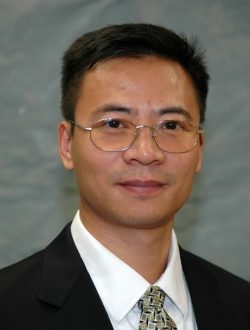Biography
Mingyu Lu received the B.S. and M.S. degrees in electronic engineering from Tsinghua University, Beijing, China in 1995 and 1997 respectively, and the Ph.D. degree in electrical engineering from the University of Illinois at Urbana-Champaign in 2002. From 2002 to 2005, he was a postdoctoral research associate at the Electromagnetics Laboratory, University of Illinois at Urbana-Champaign. He was an assistant professor with the Department of Electrical Engineering, University of Texas at Arlington from 2005 to 2012. He joined the Department of Electrical and Computer Engineering, West Virginia University Institute of Technology in 2012 and he is currently a professor. His research interest includes wireless power transmission, Internet of Things, radar systems, antenna design, and computational electromagnetics. He served as the chair of Antennas and Propagation Society of IEEE Fort Worth Section from 2006 to 2011. He is currently serving as the treasurer of IEEE West Virginia Section.
Presentations
Wireless Power Transmission based on Retro-reflective Beamforming
With the rapid development of Internet of Things, a vast number of small, low-cost, and low-power mobile electronic devices, such as radio frequency identification tags and wireless sensors, will become integral parts of our society in the near future. Supplying electrical power to these devices wirelessly would eliminate/relieve their battery life limitation, and therefore is envisioned to be one of the enabling technologies for the next-generation Internet of Things. Since wireless power delivery must be dedicated to the designated receivers in space, it is inevitable to employ one narrow electromagnetic beam as the carrier of wireless power toward each mobile device. The retro-reflective beamforming technique has excellent potential to accomplish efficient wireless power transmission in the context of Internet of Things, as it is capable of keeping track of multiple mobile devices and then generating wireless power beams to the devices accordingly. The primary merit of retro-reflective beamforming technique is that wireless power transmission is augmented by radar tracking. Specifically, wireless power transmission is initiated by pilot signals broadcasted from wireless power receiver(s); and in response to the pilot signals, a wireless power transmitter delivers directional microwave power beams to the receiver(s). This presentation reviews our past, ongoing, and future research efforts on wireless power transmission based on retro-reflective beamforming. This talk starts with the fundamental principles and a brief history of retro-reflective beamforming technique. Next, the pros and cons of retro-reflective beamforming are analyzed via comparison with other wireless power transmission techniques. Plentiful theoretical and experimental results collected in our research demonstrate that the retro-reflective beamforming scheme enables microwave power beams to follow the location of mobile wireless power receiver(s) dynamically as long as the receiver(s) broadcast pilot signals periodically. The last part of the presentation discusses the challenges pertinent to the practical application of retro-reflective beamforming technique.
